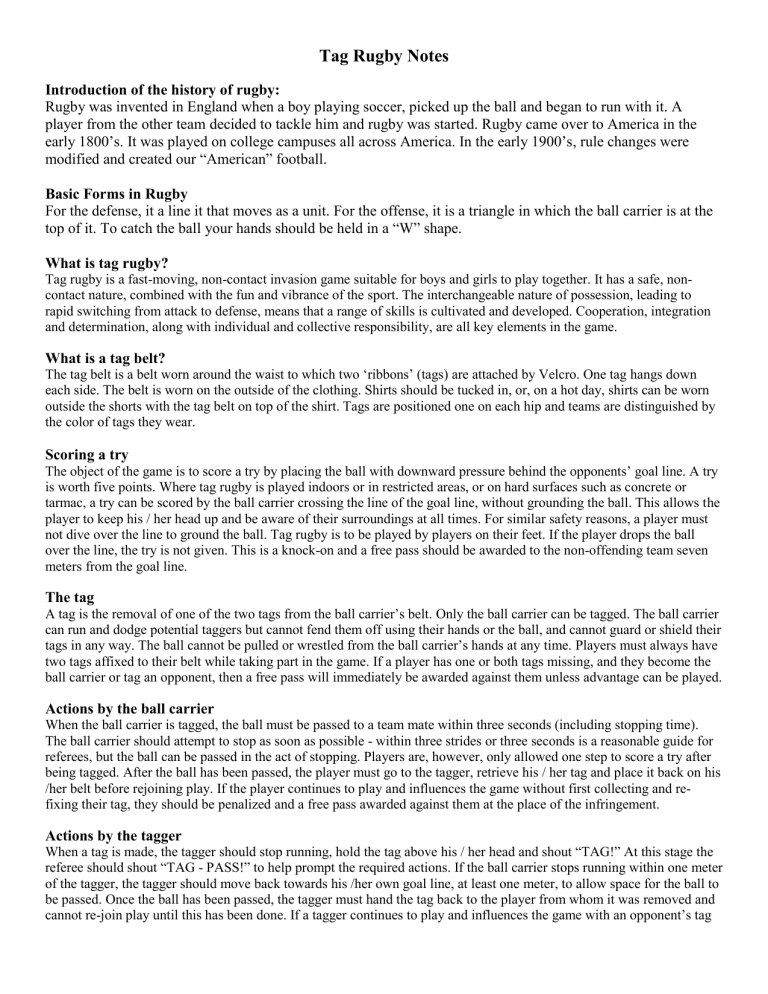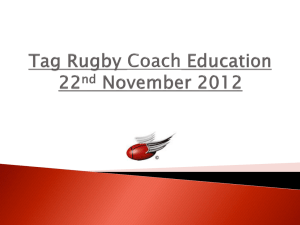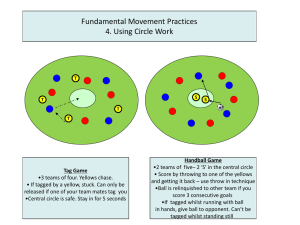Tag Rugby Notes

Tag Rugby Notes
Introduction of the history of rugby:
Rugby was invented in England when a boy playing soccer, picked up the ball and began to run with it. A player from the other team decided to tackle him and rugby was started. Rugby came over to America in the early 1800’s. It was played on college campuses all across America. In the early 1900’s, rule changes were modified and created our “American” football.
Basic Forms in Rugby
For the defense, it a line it that moves as a unit. For the offense, it is a triangle in which the ball carrier is at the top of it. To catch the ball your hands should be held in a “W” shape.
What is tag rugby?
Tag rugby is a fast-moving, non-contact invasion game suitable for boys and girls to play together. It has a safe, noncontact nature, combined with the fun and vibrance of the sport. The interchangeable nature of possession, leading to rapid switching from attack to defense, means that a range of skills is cultivated and developed. Cooperation, integration and determination, along with individual and collective responsibility, are all key elements in the game.
What is a tag belt?
The tag belt is a belt worn around the waist to which two ‘ribbons’ (tags) are attached by Velcro. One tag hangs down each side. The belt is worn on the outside of the clothing. Shirts should be tucked in, or, on a hot day, shirts can be worn outside the shorts with the tag belt on top of the shirt. Tags are positioned one on each hip and teams are distinguished by the color of tags they wear.
Scoring a try
The object of the game is to score a try by placing the ball with downward pressure behind the opponents’ goal line. A try is worth five points. Where tag rugby is played indoors or in restricted areas, or on hard surfaces such as concrete or tarmac, a try can be scored by the ball carrier crossing the line of the goal line, without grounding the ball. This allows the player to keep his / her head up and be aware of their surroundings at all times. For similar safety reasons, a player must not dive over the line to ground the ball. Tag rugby is to be played by players on their feet. If the player drops the ball over the line, the try is not given. This is a knock-on and a free pass should be awarded to the non-offending team seven meters from the goal line.
The tag
A tag is the removal of one of the two tags from the ball carrier’s belt. Only the ball carrier can be tagged. The ball carrier can run and dodge potential taggers but cannot fend them off using their hands or the ball, and cannot guard or shield their tags in any way. The ball cannot be pulled or wrestled from the ball carrier’s hands at any time. Players must always have two tags affixed to their belt while taking part in the game. If a player has one or both tags missing, and they become the ball carrier or tag an opponent, then a free pass will immediately be awarded against them unless advantage can be played.
Actions by the ball carrier
When the ball carrier is tagged, the ball must be passed to a team mate within three seconds (including stopping time).
The ball carrier should attempt to stop as soon as possible - within three strides or three seconds is a reasonable guide for referees, but the ball can be passed in the act of stopping. Players are, however, only allowed one step to score a try after being tagged. After the ball has been passed, the player must go to the tagger, retrieve his / her tag and place it back on his
/her belt before rejoining play. If the player continues to play and influences the game without first collecting and refixing their tag, they should be penalized and a free pass awarded against them at the place of the infringement.
Actions by the tagger
When a tag is made, the tagger should stop running, hold the tag above his / her head and shout “TAG!” At this stage the referee should shout “TAG - PASS!” to help prompt the required actions. If the ball carrier stops running within one meter of the tagger, the tagger should move back towards his /her own goal line, at least one meter, to allow space for the ball to be passed. Once the ball has been passed, the tagger must hand the tag back to the player from whom it was removed and cannot re-join play until this has been done. If a tagger continues to play and influences the game with an opponent’s tag
in their hand, or throws the tag to the ground, they should be penalized and a free pass awarded against them at the place of the infringement.
Knock-on
A knock-on occurs when a player, attempting to catch the ball, fumbles it and knocks it forwards to the ground towards the opponents’ goal line. A free pass is awarded to the non-offending team unless advantage can be played.
Offside
Offside only occurs immediately at the tag where the offside line is through the centre of the ball. When a tag is made, all players from the tagger’s team must attempt to retire towards their own goal line until they are behind the ball. If a player in an offside position (i.e. further forward than the ball) intercepts, prevents or slows down a pass from tagged player to a team mate, a free pass will be awarded to the non-offending team. A player can, however, run from onside to intercept a floated pass before it reaches its intended recipient.
Principles of play
In defense, players should also be looking to run forward so that they can reduce the space their opponents have to play in.
Defenders cannot physically touch the ball carrier, as the only contact allowed between the two teams is the removal of a tag from the belt of the ball carrier. Any other type of contact on the ball carrier, such as shirt pulling, running in front of or barging the ball carrier, forcing the ball carrier into touch, wrestling the ball from the ball carrier, etc, should be penalized with a free pass to the non-offending side.
Going to ground
Players should play tag rugby on their feet, with ball in hand. If the ball goes to ground, players must not dive to the floor to recover the ball or a free pass will be awarded against them. To reinforce this important safety aspect, even if the ball carrier accidentally falls to the ground with the ball, a free pass will be awarded to the non-ball carrying team. If the ball is legally passed but goes to ground, play will continue and either team may pick up the ball. If the passed ball rolls into touch, a free pass will commence from the touchline to the non-passing team.
Advantage
Instead of stopping the game every time an infraction occurs, referees should allow ‘advantage’ to the non-offending team if there is a chance that they may gain a tactical or territorial advantage. Advantage should not be played in the event of dangerous play or if a suspected injury occurs.
Kicking
There is no kicking of any kind in tag rugby.







